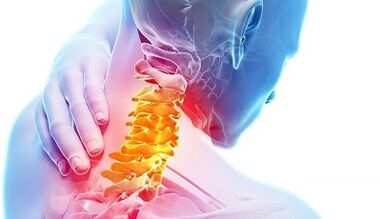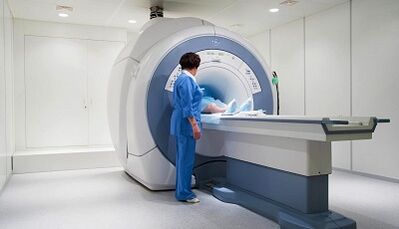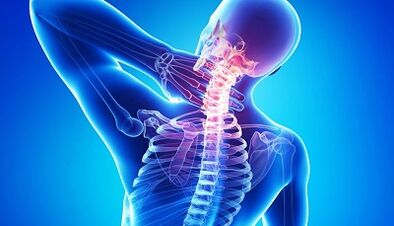Among all violations of the musculoskeletal system, the second place in relation to the prevalence is occupied by osteochondrosis of the cervical spine.The symptoms and the treatment of the disease are determined in the stage of their development, so that it is so important not to miss the signs of an impending illness.
Causes and symptoms of an osteochondrosis of the cervical spine

Osteochondrosis is called dystrophic changes in the articular cartilage against the background of the lesion of the intervertebral discs.
The cervical osteochondrosis is characterized by pathological destruction of the cartilage tissue of the vertebrae, which supports the head.
Most of the time, the disease is diagnosed in people between the ages of 30 and 40.In industrialized countries, this or another degree of cervix osteochondrosis is diagnosed in 80% of the population.
The neck is considered the mobile most mobile spine.At the same time, there is an inadequate amount of muscles around the neck that can compensate for loads on the spine.Therefore, the majority of the loads fall on the intervertebral discs that play the role of shock absorbing.
As a result, the panes are worn out, dry out and flattening, osteochondrosis develops.
The reasons that contribute to the appearance of the pathology are not only in anatomy, but also in human behavior:
- Sowoy and static, sitting work - on the computer, drive a car in the office;
- Obesity;
- Great physical exertion;
- Smoke;
- improper nutrition;
- Weak physical form;
- Spinal injuries.
Additional provocative factors in the development of osteochondrosis are: flat feet, soft mattresses and pillows, the habit, a bag on the shoulder, hypothermia and stress.
How the disease manifests itself
At the beginning of the disease about its development, only the flow of the neck, which is normally not observed.With the progress of the pathology, the number and intensity of the manifestations increase.
Characteristic symptoms of cervical osteochondrosis occur:
- Pain in the back of the back of the neck that indicate in the limbs;
- Crunch and pain when turning the head;
- Daubiness or tingling of the areas between the shoulder blades and at the base of the neck, combustion, a feeling of symptoms and stiffness;
- Headache, migraines, dizziness;
- Weakness, fatigue.
Secondary symptoms are regarded as a decrease in vision, hearing, memory problems, sleep disorders, inattentiveness, distraction and pressure.
Syndromes caused by osteochondrosis of the cervical spine

Doctors classify signs of osteochondrial processes as syndromes associated with a certain type of spine.
Stenosis.It develops against the background of the hernia of the intervertebral discs and is accompanied by a violation of the bloodstream and growth of bone tissue.It manifests itself through deafness of the limbs.
Reflex and Irite Syndrome- A consequence of the compression of the vertebral artery with curvature of the neck and an impaired attitude.It manifests itself in severe paroxysmal pain in the occipital part with gradual spread to areas around the forehead.
Rook syndrome.It is observed when the roots of the spine flattened - the consequences of a hernia.At the same time, sensitivity in the affected areas is reduced and motor activity is limited.It can be accompanied by the development of language defects, snoring, impairment of the smell, a decrease in the sensitivity of the muscles of the tongue.
The degree of development of the neck osteochondrosis
The complexity of the process is determined by the state of the pulpoose nucleus that fills the vertebral space.
Degenerative lesions of the cervix region are divided into three stages:
- First.The intervertebral disc is compressed.The hooks of the vertebrae increase.The stiffness of the muscles appears, but their mobility does not change.Small edema and pain when turning the head are possible;
- The second.Against the background of the progress of the first stage of the disease, it develops when the treatment of osteochondrosis of the cervical spine was missing or was carried out incorrectly.The intervertebral disc holes are narrowed, the height of the intervertebral discs is lower due to their flattening.Expressed nerve roots.The patient has painful pain;
- The third.Cracks in the fibrous ring that surrounds the intervertebral disc lead to breaking its capsule and the deformation of the muscle tissue.The stability of fixing the pulposcerne within the intervertebral disc is violated.Intermediate vertebrae develops.It is characterized by acute pain in the neck, the deafness of the tongue, the edema, the limitation of mobility, the curvature of the spine.
The correct position of the vertebrae of the cervical region determines the functionality of the visual and auditorial nerves, the nose, the lips, the mouth, the throat, the teeth, the facial nerve, the hypophysis, the brain, the parasympathetic nervous system, the neck muscles and forearm, the thyroid and shoulder joints.
Diagnostic methods

The exact determination of the cause of the development of osteochondrosis enables you to intentionally influence the disease.The provisional diagnosis is given after the first examination by the doctor.
The patient's symptoms about the type of pain syndromes are taken into account, as well as the information that was obtained in different positions during the examination of the spine.With the examination of the cervix compartment you can determine the presence of seals and deformations.In addition, the tone of the patient's muscles and motor skills is made aware.
Doctors receive complete diagnostic information using studies such as:
- Radiography.With the procedure you can evaluate the condition of the vertebrae in two projections - especially and on the side.The result is the determination of damage, salt deposits and compressed formations;
- Magnetic resonance imagingAllows you not only to establish pathologies of the spine, but also the severity.With the help of an MRI, a doctor can evaluate the condition and damage to the nerve ending, blood vessels and intermediate discount slices.
- Computed tomography-Digitization of information received by X -Ray radiation.
In the presence of dizziness, an additional examination of the structural change in blood vessels due to cathedral, angiography and duplex scanning may be necessary.
How do you treat cervical osteochondrosis?
After a precise diagnosis and clarification of the causes of the development of the disease, the neurologist determines how the osteochondrosis of cervical osteochondrosis is treated.
The optimal results are achieved through complex therapy that provides for the use of various methods.Protocols include drug effects, hardware methods, training therapy and therapeutic massage.
Treatment with medication

In each individual case, the medicine is selected individually.This depends not only on the severity of the pathology, but also on the specific characteristics of the patient's body.
Fixed drugs of drug treatment:
- anti -inflammatory medication - tablets that relieve pain and inflammation;
- Chondroprotectors - medication that activate the regeneration of cartilage tissue;
- External use - ointments and gels that stop pain and inflammation;
- A complex of vitamins to support the body and stimulate its restoration.
In the first stage of the therapeutic effect, it is possible to increase pain syndrome - this is the reaction of the muscle system.In order to reduce symptoms and improve the results of drug treatment, physiotherapeutic methods are used.
Physiotherapy
Physiotherapy means the effect on the cause of the disease using special equipment - electrophoresis, electrical tissue stimulation.The use of streams with low frequency improves blood circulation in the affected areas, relieves edema and pain and at the same time increases the effectiveness of medical effects.
The minimum course of the hardware treatment is 10 sessions.
Massage against neck osteochondrosis at home
Manual therapy is a productive way to influence the affected areas at home.With the help of massage, a bone, muscle cramps and pain are eliminated, the blood circulation improves and the compression of the nerve roots is reduced.
Thanks to the massage, the metabolism and spine tissue are improved.
Media sports lessons for osteochondrosis of the cervical spine
The best method to restore the functionality of the organs of the musculoskeletal system and the prevention of a relapse is physiotherapy sports lessons for osteochondrosis of the cervix region.The procedures are prescribed after complete relief of pain and inflammatory processes.
The main types of training therapy:
- Medical gymnastics;
- dosed walking;
- Classes about simulators;
- Bathe.
So that the exercises for the osteochondrosis of the cervix can be achieved, the classes must be held under the supervision of competent specialists.
Folk remedy
The complete elimination of cervical osteochondrosis using traditional medicine methods is impossible.On the other hand, the use of folk remedies enables the patient to improve, relieve inflammation, reduce pain and strengthen immunity.
On average, the therapeutic period with cervical osteochondrosis takes up to three months.If conservative treatment has not brought the expected results, surgery is used.
Why is cervical osteochondrosis dangerous?

Pathologies in the neck are a serious threat to all human health. Since the neck connects the head with the body, there is all the important biological communication in this section of the spine - arteries that feed the brain and nerve channels.
Changes in the functionality of the cervix region have the consequences in the form:
- Disorders of blood circulation and nutrition of the brain.As a result, high blood pressure, pathology of the respiratory system and the cardiovascular system, VSD, an impairment of coordination, problems with hearing, vision and language develops.
- Velceletic arteries syndrome.The pathology develops against the background to press a ship that feeds the cerebellum and an elongated brain.The development of cervical osteochondrosis can lead to ischemia and stroke;
- Radiculopathy - damage to the nerve roots, the growth of the bone tissue on the vertebrae, with a part or full loss of mobility.
The most dangerous compression of the spinal cord, which is located within the spine.Such a pathology leads to a break in the shell of the spinal cord and leads to paralysis.In particularly severe cases, the cervical osteochondrosis ends fatally.
prevention
Even after a complete recovery, the disease can return if the patient does not revise his lifestyle - the type of work and calm, habits, food.
As preventive measures, neurologists recommend the following points to consider:
- The rigidity of the mattress.The ideal option is an orthopedic mattress and a low pillow;
- A visit to the sauna is required to relax complete relaxation and removal of muscle cramps.
- The daily hot shower is a good tool to improve blood circulation in the neck.
- Swimming, walking, the blood circulation stimulates, the muscles of the spine reinforce;
- The right nutrition is the rejection of products that slow down the metabolism: fat, fried, sweet, smoked, flour and alcohol.Courts with gelatin, dairy products, nuts, vegetables, white meat and seafood are recommended.

A great physical exertion should be avoided in everyday life, sharp cints of the head, sitting for longer or a static position.In addition, it is desirable to use chairs that support the head and back.
Active life position, healthy food and morning exercises are simple but effective ways to avoid most diseases and to live a long life without pain and symptoms.




















